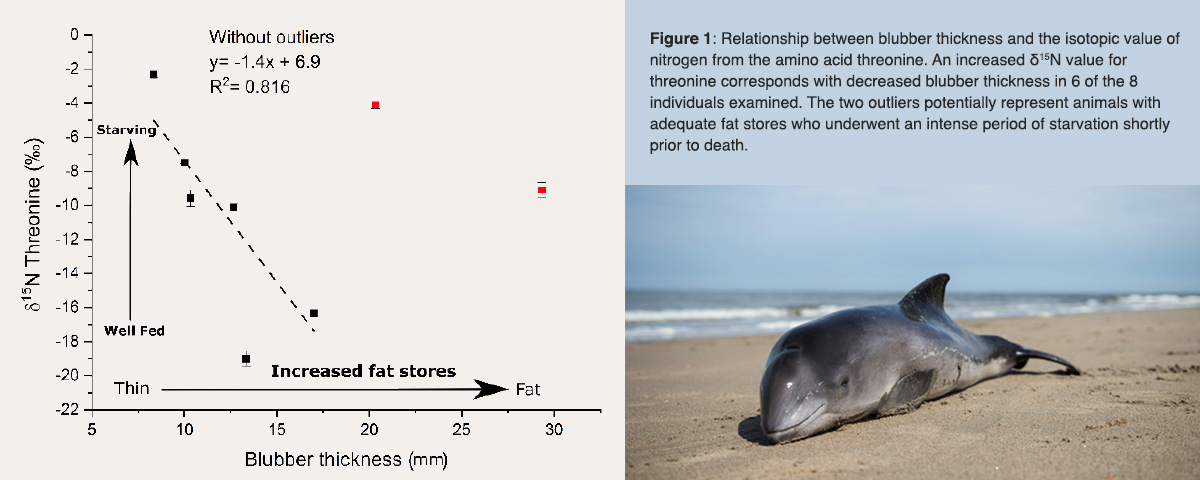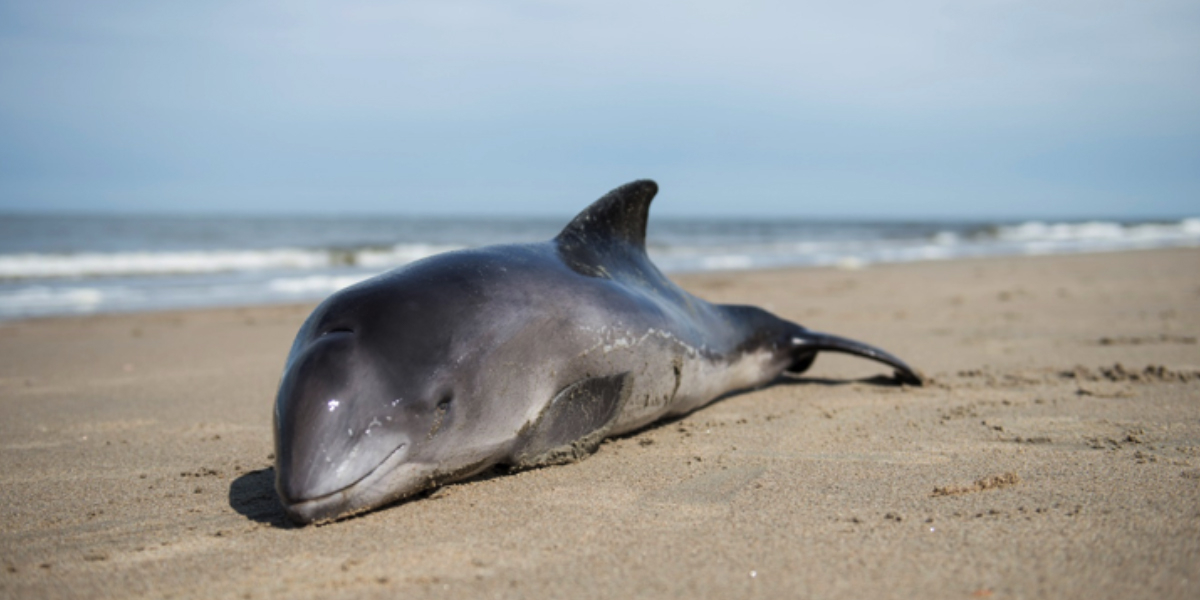Using isotopic indicators
Since 2005, harbour porpoise strandings in Europe have occurred predominantly on Dutch beaches at higher rates than expected solely due to increased population, potentially indicating a local cause. We propose to apply stable isotope analyses to multiple archived porpoise tissues (collagen, muscle, blood) and their extracted amino acids to assess where porpoises reside across their lifetimes (Wadden or North Seas, or Dutch estuaries) and the temporal extent of starvation prior to death. Combining marine mammal expertise, archived materials, and isotopic analytical capabilities between UU and NIOZ provides a unique opportunity to provide spatial and nutritional context to this apex predator.
|
|
|
Combining NIOZ isotope analytical capabilities and UU archived Harbour porpoise strandings is a great opportunity for opening new fronts for research in marine mammal isotope ecology |
| Andrea Gröne, Stefan Schouten |
Project description
Marine mammals are used as sentinels for monitoring of aquatic ecosystems, as they are relatively long-lived, highly mobile species which feed at or near the top of the food chain. Hence, understanding their abundance, distribution and ecology is very important for both ecologists and conservationists. In cases where nutritional deficiency is suspected, e.g. following stress by natural factors like reproduction or unnatural factors like disturbance from anthropogenic activities, identifying where animals have been feeding is vital to understand the relationships between health status and feeding ecology. This proposed work utilizes the changes in isotopic composition between tissue types (collagen, muscle, blood) and their extracted amino acids (AAs) to identify foraging grounds and starvation status across a three year period of the animal’s life to correlate where the animals fed between Dutch estuaries and the Wadden and North seas and nutritional condition. In the North Sea, the harbour porpoise (Phocoena phocoena) is the most abundant cetacean both in terms of sightings and strandings. Previous studies documented an increasing number of porpoises in the southern North Sea since the late 90s due to shifting of prey distribution1. However, since 2005, most harbour porpoises strandings in Europe have occurred on Dutch beaches2 indicating high temporal stranding rates in excess of those expected due to increased population.
Extensive post-mortem examinations have been conducted at UU since 2008, with data archives containing information on biological characteristics (age class, sex), health status, and causes of death of hundreds of freshly dead harbour porpoises bycaught or stranded in the Netherlands as well as an extensive tissue bank and stomach content analysis 3. Since small cetaceans, including porpoises, are described as opportunistic feeders with little to no feeding preference, the animals last meal is therefore not necessarily representative of its diet. Stomach content analyses reflect prey taken just prior to death or during dying and typically have inherent biases. The cause and manner of death affects the prey present in an animal’s stomach and can result in trophic downgrading, when sick and emaciated animals are forced to utilize less-nutritious prey lower in the food web. On top of that, stomach content analysis provides a snapshot of the animal’s last meal, but provides no information on feeding history of animals nor tipping points in nutritional intake that may have affected health condition, contributing to the death of these individuals.
Stable isotope methods
We propose to apply stable isotope (SI) methods to unravel where these animals were feeding using three different tissue types: blood to establish feeding history on a two week interval; skeletal muscle on a four month interval; and rib collagen on a 3 year interval taking into account confounding factors, including age, season, and reproductive state. We will use C, N and S isotopes to peg animals back to regional foraging grounds through matching individual tissue values to isoscapes (regional isotope maps of baseline resources) within the North- and Wadden Seas4, as well as Dutch estuaries.

A novel approach is the use of SI of amino acids5. Amino acids occur in three types: source, that undergo minimal change during metabolism and strongly retain a signal of the regional N supporting the ecosystem; trophic, which increase in a stepwise fashion depending on feeding position in the food web; and metabolic, which change values based on physiological changes in the animal (e.g. threonine, Fig. 1). Analysis of all three types of amino acids in multiple tissue types allows for simultaneous identification of temporal changes in feeding grounds (source AAs), development of trophic downgrading (trophic AAs), and starvation within individuals (metabolic AAs). We propose to use the amino acid threonine as an indicator of starvation in mammals (defined here as protein deficiency: <10% of diet; 6, 7) to develop a starvation index for marine mammals. A relationship between increased threonine values was observed in individuals with reduced blubber thickness, presumably due to a reduction in dietary protein intake within a pilot assessment using a small sample size of eight harbour porpoises (Fig. 1).Currently, there is no consensus on an appropriate measure for starvation in harbor porpoises. It can occur quickly, as porpoises feed constantly due to their small size. Therefore an animal is not necessarily emaciated but may die following a sudden discontinuation of feeding. The role of sudden discontinuation in feeding for individuals other than neonates who lost their mothers has not been analyzed before.
References
- Camphuysen C. The return of the harbour porpoise (Phocoena phocoena) in Dutch coastal waters. Lutra. 2004;47(2):113-22.
- IJsseldijk LL, ten Doeschate MT, Brownlow A, Davison NJ, Deaville R, Galatius A, Gilles A, Haelters J, Jepson PD, Keijl GO. Spatiotemporal mortality and demographic trends in a small cetacean: Strandings to inform conservation management. Biological Conservation. 2020;249:108733.
- Leopold M. Eat and be eaten: Porpoise diet studies: Wageningen University; 2015.
- St. John Glew K, Graham LJ, McGill RAR, Trueman CN. Spatial models of carbon, nitrogen and sulphur stable isotope distributions (isoscapes) across a shelf sea: An INLA approach. Methods in Ecology and Evolution. 2019;10(4):518-31.
- Riekenberg PM, van der Meer M, Schouten S. Practical considerations for improved reliability and precision during determination of δ15N values in amino acids using a single combined oxidation-reduction reactor. Rapid Communications in Mass Spectrometry. 2020;34(14):e8797.
- Lübcker N, Whiteman JP, Millar RP, de Bruyn PJN, Newsome SD. Fasting affects amino acid nitrogen isotope values: a new tool for identifying nitrogen balance of free-ranging mammals. Oecologia. 2020.
- Fuller BT, Petzke KJ. The dietary protein paradox and threonine 15N-depletion: Pyridoxal-5'-phosphate enzyme activity as a mechanism for the δ15N trophic level effect. Rapid Communications in Mass Spectrometry. 2017;31(8):705-18.

Connected themes
- Sunstainable functioning of Coastal and Shelf Seas


